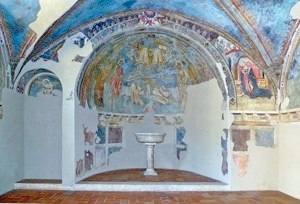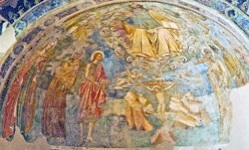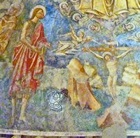
This chapel (the 1st on the left), which now serves as the Baptistery, was probably built in the 15th century.
Frescoes (late 15th century)


Apse Right wall
The earliest surviving reference to these frescoes dates to 1897, when they were in a ruinous state. They were restored in the 1970s and attributed to an artist from Foligno. The frescoes depict:
-
✴Entrance arch - five tondi:
-
•the monogram “IHS” at the top;
-
•busts of young men on each side; and
-
•arms of Perugia on each side, at the bottom.
-
✴Left wall:
-
•SS Peter and Paul (flanking the window);
-
•Baglioni arms (under the architrave of the window).
-
✴Back wall (illustrated above):
-
•Pietà (in the niche to the left);
-
•Annunciation (in the spandrels of the entrance arch);
-
•hand of God between seraphim (at the top of the arch); and
-
•in the shallow niche:
-
-Christ in judgement, within a mandorla of angels (above);
-
-Crucifixion, with a kneeling donor in armour to the left (see below); and
-
-SS Catherine of Alexandria, Francis and John the Baptist (to the left); and
-
-St Andrew, a bishop saint and a female saint (to the right).
-
✴Right wall:
-
•Madonna and child enthroned with two angels; and
-
•the penitent St Jerome; and
-
✴Vault: the lamb of God.

Corrado Fratini (referenced below) argues convincingly that the circumstances of this murder probably explain the reason for the subsequent neglect of the work. Grifonetto had been one of the perpetrators of the the carnage of the “Nozze Rosse” (red wedding or wedding of blood) of Astorre Baglioni, which convulsed the Baglioni family in 1500. His faction was unable to hold on to power, and many of its members, including Grifonetto, died in the subsequent fighting. Gian Paolo and Troilo Baglioni, who belonged to victorious faction, underlined their newly-established dominance of Spello by embellishing the Cappella Bella, Santa Maria Maggiore, while the chapel that commemorated their murdered enemy was allowed to descend into ruin.






